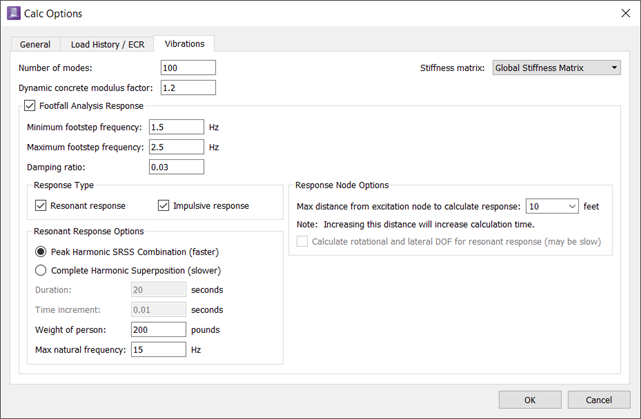|
Number of modes
|
The number of modes for RAM Concept to calculate in the Eigenvalue analysis. |
|
Dynamic concrete modulus factor
|
The ratio of concrete modulus of elasticity to use in the dynamic analysis over the concrete modulus of elasticity defined for the static analysis. |
|
Stiffness matrix
|
Controls the stiffness matrix that is used to solve the Eigenvalue analysis. The global linear elastic analysis model can be used, or any load history step can be selected. |
|
Minimum footstep frequency
|
The minimum footstep frequency to consider in the footfall analysis. Normal footstep rates range from 1.5 to 2.5 Hz. |
|
Maximum footstep frequency
|
The maximum footstep frequency to consider in the footfall analysis. Normal footstep rates range from 1.5 to 2.5 Hz. |
|
Damping Ratio
|
The damping ratio to use in the vibration analysis, as a fraction of critical damping (damping ratio = 1). Normal range for concrete buildings is 0.01 to 0.04. |
| Response Type |
Select one or both of the types: | Type | Description |
|---|
| Resonant response |
Check this option to perform a resonant response calculation. A resonant response tends to build up over time, and is generally most critical for lower frequency modes less than about 4 times the footstep frequency. |
| Impulsive response |
Check this option to perform an impulsive response calculation. An impulsive response tends to dissipate before the next footstep, and is generally most critical for higher frequency modes. |
|
| Resonant Response Options |
| Option | Description |
|---|
|
Peak Harmonic SRSS Combination (faster) |
This analysis uses a fast calculation technique that
is generally suitable for day to day design where RMS velocity
values are not required. |
|
Complete Harmonic Superposition (slower)
|
This analysis uses a comprehensive dynamic modal
superposition analysis which is suitable for structures that are
vibrationally sensitive or if RMS velocity values are required.
|
| Parameter | Description |
|---|
|
Duration, Time Increment
|
Defines the number of time points that are used to calculate the modal analysis. The duration should generally be set to capture at least 30 cycles of forcing and the time increment should be set to at least 10 times shorter than the 4th harmonic of the fastest walking frequency. |
|
Weight of Person
|
The static weight of the person walking. |
|
Max natural frequency
|
Defines the maximum natural frequency that is used in the dynamic analysis for the resonant response. |
|
| Resonant Node Options |
| Option | Description |
|---|
| Max distance from excitation node to calculate response |
Controls the number of excitation nodes considered in the analysis. Increasing this distance will increase the number of response calculations and increase analysis time. |
| Calculate rotational and lateral DOF for resonant response |
Active for the Complete Harmonic Analysis (slower) option only. Includes the lateral and angular degree of freedoms in the resonant response calculations. These components are rarely critical for floor vibrations and including them in the analysis increases analysis time. |
|

